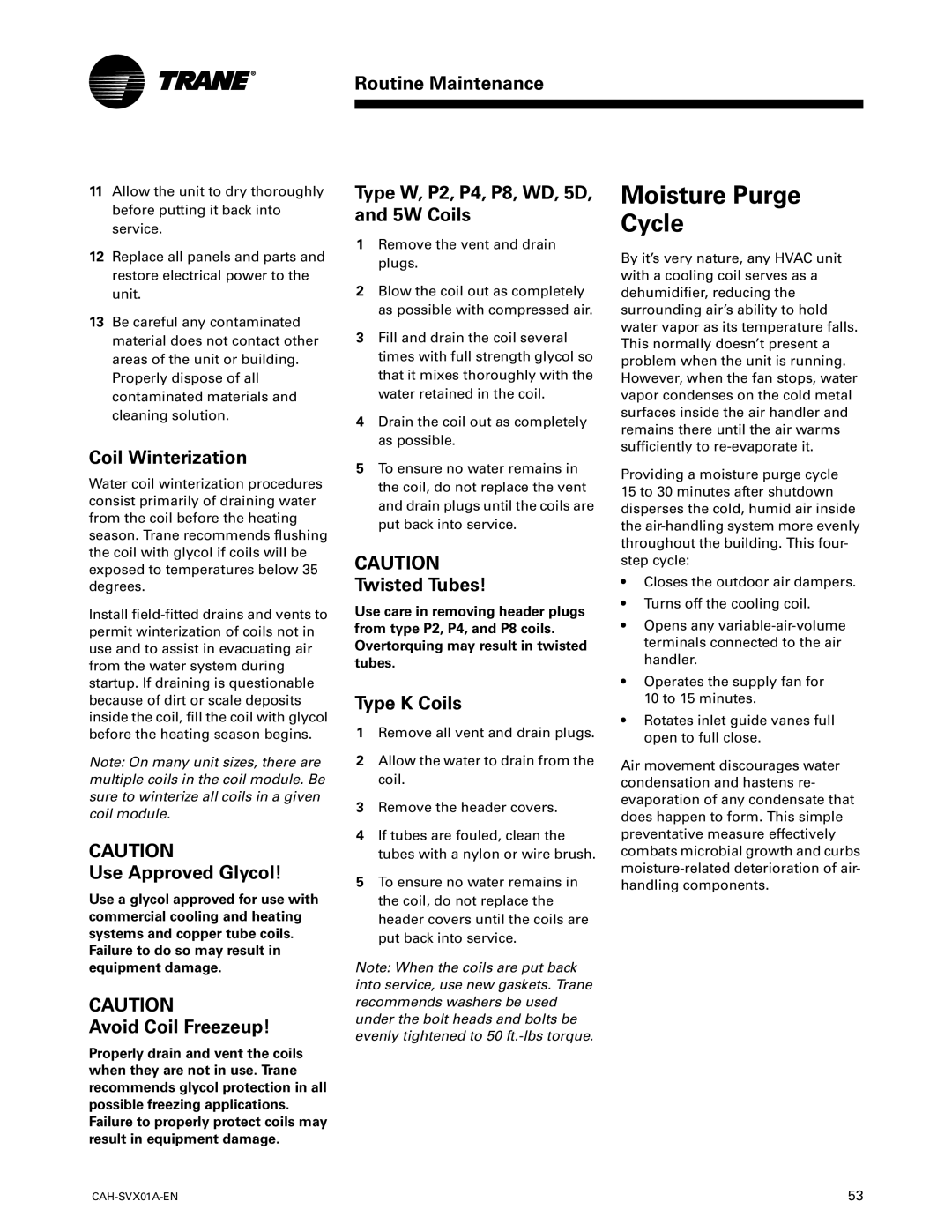Routine Maintenance
11Allow the unit to dry thoroughly before putting it back into service.
12Replace all panels and parts and restore electrical power to the unit.
13Be careful any contaminated material does not contact other areas of the unit or building. Properly dispose of all contaminated materials and cleaning solution.
Coil Winterization
Water coil winterization procedures consist primarily of draining water from the coil before the heating season. Trane recommends flushing the coil with glycol if coils will be exposed to temperatures below 35 degrees.
Install
Note: On many unit sizes, there are multiple coils in the coil module. Be sure to winterize all coils in a given coil module.
CAUTION
Use Approved Glycol!
Use a glycol approved for use with commercial cooling and heating systems and copper tube coils. Failure to do so may result in equipment damage.
CAUTION
Avoid Coil Freezeup!
Properly drain and vent the coils when they are not in use. Trane recommends glycol protection in all possible freezing applications. Failure to properly protect coils may result in equipment damage.
Type W, P2, P4, P8, WD, 5D, and 5W Coils
1Remove the vent and drain plugs.
2Blow the coil out as completely as possible with compressed air.
3Fill and drain the coil several times with full strength glycol so that it mixes thoroughly with the water retained in the coil.
4Drain the coil out as completely as possible.
5To ensure no water remains in the coil, do not replace the vent and drain plugs until the coils are put back into service.
CAUTION
Twisted Tubes!
Use care in removing header plugs from type P2, P4, and P8 coils. Overtorquing may result in twisted tubes.
Type K Coils
1Remove all vent and drain plugs.
2Allow the water to drain from the coil.
3Remove the header covers.
4If tubes are fouled, clean the tubes with a nylon or wire brush.
5To ensure no water remains in the coil, do not replace the header covers until the coils are put back into service.
Note: When the coils are put back into service, use new gaskets. Trane recommends washers be used under the bolt heads and bolts be evenly tightened to 50
Moisture Purge Cycle
By it’s very nature, any HVAC unit with a cooling coil serves as a dehumidifier, reducing the surrounding air’s ability to hold water vapor as its temperature falls. This normally doesn’t present a problem when the unit is running. However, when the fan stops, water vapor condenses on the cold metal surfaces inside the air handler and remains there until the air warms sufficiently to
Providing a moisture purge cycle 15 to 30 minutes after shutdown disperses the cold, humid air inside the
•Closes the outdoor air dampers.
•Turns off the cooling coil.
•Opens any
•Operates the supply fan for 10 to 15 minutes.
•Rotates inlet guide vanes full open to full close.
Air movement discourages water condensation and hastens re- evaporation of any condensate that does happen to form. This simple preventative measure effectively combats microbial growth and curbs
| 53 |
